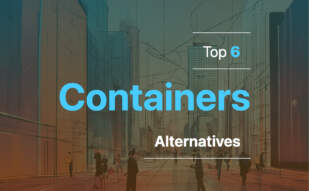Java Virtual Machine is a program that executes other programs, providing a portable execution environment for Java-based apps. It enhances performance, stability, and consistent runtimes, supporting multiple languages and managing memory efficiently through “Garbage Collection”.

For those in search of alternatives to Java Virtual Machine, options include Docker, Containers, WASM, Ethereum Virtual Machine, ReactJS, and JavaScript.
Docker

Meet Docker—a marvel in the tech world renowned for its groundbreaking container technology. This open-source game-changer, launched in 2013, is all set to standardize your software deployment needs.
Docker Top Features
- Container Technology: Docker perfectly packages Codec, runtime, system tools, libraries, and settings into standardized software units. Forget dependencies; say hello to reliable executions.
- Cross-Platform Compatibility: Whether it’s Linux or Windows-based applications, Docker has got you covered. Run your software across different computing environments effortlessly.
- Cost-Effective: Sharing the machine’s operating system cut down on server and licensing costs.
- Flexible Application Management: Using containers and virtual machines together, Docker boosts your application management to new heights of flexibility.
- Security and Performance: With Docker’s container technology, you get enhanced security and better performance, managing resources has never been easier.
| Beneficial Aspects | Description |
|---|---|
| Integration and Workload Portability | With continous integration and delivery workflows, moving your workload to new platforms is easier than ever. |
| Easy Management Runtimes | No more heavy runtimes. Docker containers are lightweight, easy to set up, and require less management overhead. |
| Industry Standardization | Thank Docker for industry standardization. Major data center vendors and cloud providers swear by it. |
Docker Downsides
- Being open-source, Docker demands technical proficiency to operate.
- Despite Docker’s enhancements, security woes still linger with container technology.
Docker Use Cases
Software Developers
With Docker’s container technology, software developers can rejoice in unprecedented application management flexibility and reliable software development across a range of computing environments.
Data Center Vendors
Data center vendors have recognized Docker as a trusted partner. With streamlined resource management and efficiency, cost-effective solutions are just a Docker away.
Enterprise IT Infrastructure
Challenging the status quo, Docker offers enterprises the chance to manage their infrastructure in the same manner as applications, enhancing even further the speed of your software deliveries.
Containers

Delving into the realm of augmented actuality, where software dances liberated from the chains of infrastructure, we encounter the containers. Akin to sandboxes crafting isolated enclaves for apps and their dependencies, containers gift us the magic of software portability, consistency, and swift deployment. Enter a harmonious world tinted by the empowering hues of Docker, FreeBSD Jails, Linux VServer, Solaris Containers, Open VZ, Process Containers, LXC and more.
Containers Top Features
- Portability: Containers, unscathed by hosting environment, operating system, or hardware variations, aid in the smooth sailing of applications.
- Isolation and Security: Each container functions within its own fortress, gifting it immunity and empowering many such citadels to run simultaneously on a host.
- Swiftness: Docker, an open platform that nestles applications in the warmth of containers, delivers software with the speed of the rushing wind, owing to its lightweight nature.
- Lifecycle Management: Docker provides platforms and tools, mapping out an unbroken ring that manages the lifecycle of containers.
- High Workload Portability: Docker’s container-based platform facilitates the smooth sailing of workloads.
- Image Reusability: Docker Images, a composition of multiple read-only template layers, are available in public or private repositories for reuse.
| Feature | Details |
|---|---|
| Docker client-server architecture | The Docker client communicates with the Docker daemon, personifying a harmonious symphony of data transfer and command execution. |
| Advance Container Technologies | In the mystic scrolls of antiquity, we find names such as FreeBSD Jails, Linux VServer, Solaris Containers, Open VZ, Process Containers, and LXC marked as pioneers of container technologies. |
| Control Panels | With tools like Ceph, REX-Ray, Flannel, Jenkins, managing containers becomes a symphony of orchestrated command execution. |
Containers Limitations
- Docker Licensing Complexities: A whitepaper by the Linux Foundation probes into the intricacies of OpenSource Licensing for Docker Containers.
- Image Licensing: The software stored in Docker image layers must conform to definite licensing conditions, necessitating deep knowledge.
- Source Code Management: Docker’s ecosystem does not facilitate automatic gathering and publishing of source code, hinting at a conundrum yet unsolved.
Containers Use Cases
Use case 1 – Hybrid Cloud Solutions
The whispers of adopting serverless technology and hybrid cloud solutions rise from the tongues of Kubernetes, VMware, RedHat, and Rancher. Seek out company giants like IBM Cloud Paks, Google Anthos, AWS Outposts, Azure Arc. Find them setting the stage ablaze with Kubernetes as their standard management platform for containers.
Use case 2 – Large Scale Software Infrastructure
Since the dawn of 2013, Docker has etched its significance into the stone tablets of large-scale software infrastructure. Tracing this path shall lead you to greater wisdom in the administration of container-dependent applications.
Use case 3 – Container Management
With the rise of the majestic Docker, containerd, CRI-O, rkt, one discovered new ways to tame the container beasts. By adopting container management tools like Ceph, REX-Ray, Flannel, Jenkins, one ensures a well-managed kingdom, safe and effervescent.
WASM
Let’s imagine browsing the web with a turbo boost! WebAssembly (WASM), is your next-gen virtual machine that’s pumping steroids into your traditional JavaScript, taking web performance to new levels since its establishment in 2017!
WASM’s Hall of Fame
- Unhindered Performance: Providing near-native speed, it steps in where JavaScript gasps for performance, making AR, VR and video editing a breeze online!
- Multilingual: Write in whichever language you please; WASM doesn’t mind. It supports C, C++, Rust, Python, and Go be it.
- Cross-platform Gymnastics: WASM is flexible, showing off its versatility in edge-based environments, mobile, and even serverless ecosystems.
- Boosted JavaScript: It supercharges JavaScript, making the pair a dynamic duo in-browser use cases.
- Improved Security: WASM aims to make the browser world a safer place, reducing vulnerability attack surfaces and championing better memory safety.
| Applications | P2P services, Scientific simulations, Computer vision |
| Key Concepts | Module, Memory, Table, Instance |
| Binary instruction format | Fosters fast, efficient, portable performance |
WASM – Behind the Curtains
- Memory Management: Though it offers better memory management, a limited set of instructions keeps it wanting for more.
- Safety Program: WASM is that super-security guard, but its stringent memory safety measures can sometimes pull back the freedom JavaScript lovers unreservedly enjoy.
Pocket Pinch
“How much for this tech-titan?” I hear you ask. Good news! WASM is your friendly free-spirited VM, open-source and equally open-hearted. Mimic the generosity it shows your code and spread the word!
WASM for Warriors
Compact Code Connoisseurs
Are you one from the lot that prefer code as neat as a pin? WASM lets you share libraries, regardless of the underlying language. No more hours of implementing the same algorithms in different languages!
Frontend Fanatics
What if we told you that you could create complete apps without getting entangled in multiple interfaces? With WASM, frontend developers unlock a new realm of possibilities!
Server(less) Samaritans
Struggling with serverless adoption issues? WASM promises delivery wherever a CPU instruction can operate – enabling smooth performance across different containers, Kubernetes clusters, and multicloud environments.
Ethereum Virtual Machine
Envision a digital realm that serves as the foundational stage for smart contracts. Welcome to the Ethereum Virtual Machine (EVM), a runtime environment that births and runs Ethereum accounts and smart contracts, and encapsulates the nerve-centre of the Ethereum blockchain. This Turing-complete system affords developers the capability for coding in numerous languages.
Ethereum Virtual Machine Top Features
- Versatile architecture: Think of EVM as an ever-changing, distributed state machine that faithfully executes transactions from block to block.
- Flexibility: It’s less of a machine, more of a mathematical function, accepting a valid previous state (old state) and a group of legitimate transactions to produce a new valid state.
- Stack machine execution: Operates instructions as a stack machine, capable of delving to a 1024-item depth.
- Standalone implementations: Beyond Ethereum execution clients, standalone options like Py-EVM, evmone, ethereumjs-vm and eEVM are available.
- Powerful Blockchain support: Powering Ethereum’s blockchain, EVM manages the native ETH token, regulates transactions, participates in block creation and performs transaction execution.
- Data safety: Allows untrusted code execution without risking data safety. Ideal for complex smart contracts.
| Feature | Benefit |
| Decentralization | Supports decentralization and allows the creation of Distributed Applications (DApps). |
| Stateful Contracts | Ensures robustness against failures and provides deterministic processing. |
| Ethereum WebAssembly (eWASM) | Future shift from EVM to eWASM fosters innovation and scalability. |
Ethereum Virtual Machine Downsides
- High cost: Data storage can be quite high due to gas cost.
- Technical Expertise: Coding smart contracts require significant expertise.
Ethereum Virtual Machine Pricing
Being an intrinsic part of the open-source Ethereum platform, the Ethereum Virtual Machine can be used without incurring any direct fees. However, operations inside the EVM are subject to gas costs – a mechanism in place to prevent spam and keep the network healthy.
Ethereum Virtual Machine Use Cases
Use case 1:
All smart contract developers benefit massively as EVM provides a stable and flexible environment required for the execution and governance of smart contracts.
Use case 2:
DApp creators find in EVM an ideal and secure platform; this is crucial in creating and deploying decentralized applications with ease.
Use case 3:
Blockchain experts make use of evaluating and participating in consensus determination, transaction execution and native token management.
ReactJS

An open-source JavaScript library, ReactJS fuses technology’s dynamic essence with a culture of simplicity to create interactive applications and unfurl an era of dynamic UI/UX designs across the web and mobile-based platforms with an enviable track record of performance. Brought to life by Facebook in the year of 2011, it’s a quintessential entity that has been adopted predominantly by giants such as Netflix and Instagram, encouraging cross-cultural data sharing and digital diversity.
ReactJS Top Features
- JSX: The harmony of HTML and JavaScript translating code into JavaScript through the Babel compiler, simplifying the coding process.
- Virtual DOM: A replica of the real DOM only updating the altered parts, reinforcing performance and speed.
- One-Way Data Binding: Data flow is sustained from parent to child components.
- React Extensions: Advancing full-fledged UI applications, mobile app development, and server-side rendering.
- Conditional Statements: JSX allows data display based on variable conditions.
- Simplicity: The amity of HTML and JavaScript in JSX makes coding and debugging easier with reusable components.
| Specifications | Details |
|---|---|
| Current Version | V17.0.1 |
| First Deployment | Facebook News Feed |
| Popularity Index | Top 10 Programming Languages |
ReactJS Downsides
- Despite its unidirectional data flow, properties in child components cannot return data to parent components but can only request data modification.
- The high pace of development could lead to frequent updates, impacting stability.
- Understanding and coding in JSX may require a learning curve for beginners.
ReactJS Pricing
As an epitome of open-source culture, ReactJS is available to all digital enthusiasts free of charge, promoting equal access in the global tech community.
ReactJS Use Cases
Use case 1 – High-performance Web Applications
ReactJS, with its efficient virtual DOM, caters to high-performance web applications, refining speed and user experience.
Use case 2 – SEO-Friendly Web Applications
Create SEO-friendly web applications benefitting from server-side rendering by ReactJS.
Use case 3 – Component-Based UI Development
With ReactJS, develop neat UIs by dividing them into multiple components, ensuring clean programming and fast performance.
JavaScript
Introducing JavaScript -a dynamic, lightweight computer programming language known for turning ordinary web pages into interactive experiences.
JavaScript Top Features
- Dynamic: Enables client-side scripting for user interaction, creating a more immersive browsing experience.
- Object-oriented capabilities: Perfect for creating network-centric applications.
- Less server interaction: JavaScript executes on the client side, reducing the load on the server.
| Node.js compatibility | JavaScript can be utilized beyond browser context with Node.js. |
| Interoperability | Embedded successfully in well-known browsers such as Netscape and Internet Explorer. |
| Standardized | Defined by the ECMA-262 standard, leading to more predictable, consistent use. |
JavaScript Limitations
- File handling: JavaScript does not support reading/writing of files for security reasons.
- Parallel processing: Does not offer multi-threading/multiprocessor capabilities.
JavaScript Use Cases
Real-time validation
With JavaScript’s client-side validation, users receive immediate feedback, improving user experience.
Interactive Web Development
JavaScript enhances interaction on websites such as Facebook or Twitter with its dynamic capabilities.
Back-End Services
With Node.js, JavaScript extends to server-side environments, enabling web server development.
Grant Sullivan
Content writer @ Aircada and self proclaimed board game strategist by day, AI developer by night.





